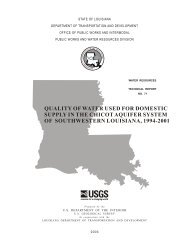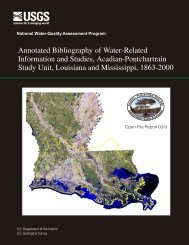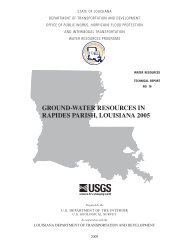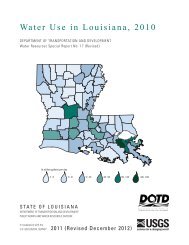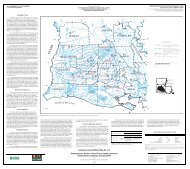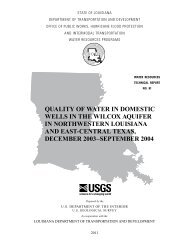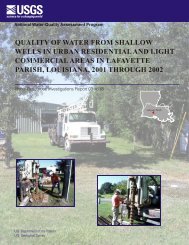environmental setting, water quality, and ecological indicators of
environmental setting, water quality, and ecological indicators of
environmental setting, water quality, and ecological indicators of
You also want an ePaper? Increase the reach of your titles
YUMPU automatically turns print PDFs into web optimized ePapers that Google loves.
Water-<strong>quality</strong> data were compared to drinking<strong>water</strong><br />
<strong>and</strong> aquatic-life criteria <strong>and</strong> bed-sediment data<br />
were compared to aquatic-life criteria. Water-<strong>quality</strong><br />
data were analyzed statistically <strong>and</strong> related to agricultural<br />
l<strong>and</strong>-use intensity. Samples from 29 wells <strong>and</strong> 24<br />
stream sites analyzed for selected nutrients, major inorganic<br />
ions, <strong>and</strong> pesticides indicate the following:<br />
Nutrients<br />
Concentrations <strong>of</strong> nutrients <strong>and</strong> major inorganic<br />
ions in ground <strong>and</strong> surface <strong>water</strong> generally were<br />
largest in the southeastern part <strong>of</strong> the study area, an<br />
area <strong>of</strong> intense agriculture.<br />
The only drinking <strong>water</strong> regulation exceeded in a<br />
ground-<strong>water</strong> sample was that for nitrate in a well<br />
located in an area previously used for raising poultry<br />
<strong>and</strong> swine.<br />
Concentrations <strong>of</strong> nutrients from ground <strong>water</strong> used<br />
for agricultural irrigation were not high enough to<br />
contribute to eutrophication in surface <strong>water</strong>.<br />
The greatest potential for eutrophic conditions in<br />
surface <strong>water</strong>, based on nutrient thresholds,<br />
occurred March-May, at about the same time or<br />
shortly after ricefields were drained.<br />
Major Inorganic Ions <strong>and</strong> Trace Elements<br />
Secondary Maximum Contaminant Levels established<br />
by the U.S. Environmental Protection<br />
Agency were exceeded in samples from 20 wells—<br />
sulfate in 1 well, chloride in 4 wells, iron in 7 wells,<br />
<strong>and</strong> manganese in 17 wells.<br />
Secondary Maximum Contaminant Levels were<br />
exceeded in samples from all surface-<strong>water</strong> sites—<br />
iron at 8 sites, <strong>and</strong> manganese at all sites.<br />
The maximum concentrations <strong>of</strong> sodium <strong>and</strong> chloride<br />
in surface <strong>water</strong> occurred at Bayou Lacassine<br />
near Lake Arthur <strong>and</strong> probably resulted from salt<strong>water</strong><br />
intrusion induced by reverse flow during the<br />
drought.<br />
Pesticides<br />
Fewer pesticides <strong>and</strong> degradation products were<br />
detected in ground <strong>water</strong> than in surface <strong>water</strong>.<br />
Concentrations were lower in ground <strong>water</strong> than in<br />
surface <strong>water</strong>, <strong>and</strong> did not exceed drinking <strong>water</strong> or<br />
aquatic life criteria. Concentrations were detected<br />
in less than 1 percent <strong>of</strong> all analyses; 19 pesticides<br />
<strong>and</strong> degradation products were detected in samples<br />
from 11 wells.<br />
Pesticides <strong>and</strong> degradation products most frequently<br />
detected in ground <strong>water</strong> were the herbicides<br />
bentazon <strong>and</strong> atrazine.<br />
Concentrations <strong>of</strong> 47 pesticides <strong>and</strong> degradation<br />
products were detected in surface <strong>water</strong>. At least 3<br />
43<br />
pesticides were detected in all surface-<strong>water</strong> samples.<br />
In 72 percent <strong>of</strong> the samples at least<br />
5 hydrophylic pesticides were detected, <strong>and</strong> in more<br />
than 70 percent <strong>of</strong> the samples at least 3 hydrophobic<br />
pesticides were detected.<br />
Although atrazine concentrations in three surface<strong>water</strong><br />
samples exceeded 3 µg/L (micrograms per<br />
liter), the Maximum Contaminant Level established<br />
by the U.S. Environmental Protection Agency was<br />
not exceeded because it is based on an annual average<br />
<strong>of</strong> quarterly samples. Concentrations larger<br />
than 3.0 µg/L were not detected in samples collected<br />
during other times <strong>of</strong> the year, <strong>and</strong> the average<br />
annual concentrations did not exceed 3 µg/L for<br />
sites sampled throughout the year.<br />
Pesticides concentrations in surface <strong>water</strong> exceeded<br />
aquatic-life criteria for atrazine (1.8 µg/L), tebuthiuron<br />
(1.6 µg/L), <strong>and</strong> malathion (0.1 µg/L).<br />
Fipronil was detected in concentrations exceeding<br />
the numeric targets for acute total maximum daily<br />
loads (2.30 µg/L) at 3 surface-<strong>water</strong> sites <strong>and</strong> the<br />
numeric targets for chronic total maximum daily<br />
loads (4.6 µg/L) at 14 sites.<br />
Maximum pesticide concentrations in surface <strong>water</strong><br />
usually occurred in the spring at about the same<br />
time or shortly after ricefields were drained.<br />
Concentrations <strong>of</strong> DDE in bed sediment at Des<br />
Cannes <strong>and</strong> Church Point sites exceeded interim<br />
fresh<strong>water</strong> sediment-<strong>quality</strong> guidelines for the protection<br />
<strong>of</strong> aquatic life.<br />
Fipronil sulfide was detected at all bed-sediment<br />
sites, but there are no current (2002) guidelines with<br />
which to evaluate the <strong>environmental</strong> effects <strong>of</strong><br />
fipronil <strong>and</strong> degradation products.<br />
The study design, based on drainage basin area <strong>and</strong><br />
agricultural l<strong>and</strong>-use intensity, was used to determine<br />
differences in natural <strong>and</strong> human-related influences on<br />
surface-<strong>water</strong> <strong>quality</strong> at 19 <strong>ecological</strong> data-collection<br />
sites. Aquatic invertebrate communities were used as<br />
<strong>indicators</strong> <strong>of</strong> surface-<strong>water</strong> <strong>quality</strong> <strong>and</strong> habitat conditions<br />
at these sites. Canonical correspondence analysis (CCA)<br />
identified four significant <strong>environmental</strong> variables<br />
(instream cover score, percentage <strong>of</strong> open canopy, <strong>and</strong><br />
concentrations <strong>of</strong> dissolved oxygen <strong>and</strong> maximum dissolved<br />
fipronil) that described the distribution <strong>of</strong> aquatic<br />
invertebrate communities among <strong>ecological</strong> data-collection<br />
sites. Cluster analysis revealed four site groups<br />
which separated <strong>ecological</strong> data-collection sites geographically<br />
within the study. Environmental data <strong>and</strong><br />
aquatic invertebrate metrics within the study design <strong>and</strong><br />
CCA-assigned site groups were compared <strong>and</strong> indicate<br />
the following:



